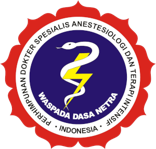Anesthetic Management for Urgent Caesarean Section in Patient with Uncontrolled Hyperthyroidism and Severe Mitral Regurgitation
Abstract
Background :The prevalence of hyperthyroidism in pregnancy approximately 0.05% to 3% and mostly caused by Graves’ Disease (GD). The prevalence of Hyperthyroid Heart Disease (HHD) in pregnancy is 3.87%. Uncontrolled hyperthyroidism during pregnancy can increase maternal and fetal mortality. We report a case of a pregnant woman with uncontrolled hyperthyroidism and severe mitral regurgitation that underwent cesarean section with spinal anesthesia for delivery.
Case Illustration :A 33 years-old patient G4P1A2 visited the Obstetric-Gynecology outpatient clinic at our hospital at 23 weeks of gestation (WoG) due to uncontrolled hyperthyroidism caused by GD that diagnosed 3 years ago and shortness of breath. The echocardiography test obtained severe mitral regurgitation and left atrial dilatation with 58% LVEF. It was decided to maintain the pregnancy till the fetus is viable while still monitoring the patient’s condition. At 32 WoG, the patient came to the ED due to shortness of breath, chest pain, and nausea. Fetal movement and fetal heart rate (FHR) were within normal limits. The patient was given a nasal cannula at 3 liters/minute, extra furosemide 20 mg, and fetal lung maturation with dexamethasone injection. The patient was prepared for termination by cesarean section. Spinal anesthesia was performed in a sitting position using a 27 G spinal needle. Inserted at L 3-4, using a low dose of heavy bupivacaine 0.5% 7.5 mg combined with 25 g fentanyl and 0.1 mg morphine intrathecally. C-section was successfully performed and hemodynamics during surgery was stable, resulting the delivery of a preterm baby who weighed 1.9 kg at birth and the baby was transferred to the NICU for further treatment.
Conclusion : Spinal anesthesia with low dose bupivacaine combined with opioids for cesarean section was revealed maternal and neonate safe.
Keywords
Full Text:
PDFReferences
Bahn RS, Burch HB, Cooper DS, Garber JR, Greenlee MC, Klein I, et al. Hyperthyroidism and other causes of thyrotoxicosis: Management guidelines of the American Thyroid Association and American Association of Clinical Endocrinologists. Thyroid. 2011;21(6):593–646.
2. Shan D, Bai Y, Chen QH, Wu YX, Chen Q, Hu YY. Hyperthyroid heart disease in pregnancy: Retrospective analysis of a case series and review of the literature. World J Clin Cases. 2019;7(19):2953–62.
3. Fox T. Mitral valve chord rupture in a pregnant patient with uncontrolled hyperthyroidism. 2022;(July):8–11.
4. Park S, Choi S, Jeong J, Kim J. Spinal anesthesia for urgent Cesarean section in a patient with uncontrolled hyperthyroidism due to Graves’ disease - A case report -. Anesth Pain Med. 2020;15(3):319–24.
5. Jiskra J. Hyperthyroidism and the heart. Kardiol Rev. 2018;20(3):167–72.
6. Nguyen CT, Sasso EB, Barton L, Mestman JH. Graves’ hyperthyroidism in pregnancy: a clinical review. Clin Diabetes Endocrinol. 2018;4(1):1–9.
7. Isngadi I, Hartono R, Husodo DP, Prasedya ES. Low dose hyperbaric bupivacaine 5 mg combined with 50 mcg fentanyl for cesarean section in maternal heart disease. Anaesthesia, Pain Intensive Care. 2019;23(3):274–8.
8. Luthra A, Bajaj R, Jafra A, Jangra K, Arya V. Anesthesia in pregnancy with heart disease. Saudi J Anaesth 2017;11(4):454–71. [Pubmed] [Free Full Text] DOI: 10.4103/sja. SJA_277_17.
9. Fanniyah F, Isngadi I. Anesthesia Management for Section Cesarean Delivery in Patient with Severe Mitral Stenosis. Solo J Anesth Pain Crit Care. 2022;2(1):1.
10. Khosravi F, Sharifi M, Jarineshin H. Comparative study of fentanyl vs dexmedetomidine as adjuvants to intrathecal bupivacaine in Cesarean section: A randomized, double-blind clinical trial. J Pain Res. 2020;13:2475–82.
11. Ferrarezi WPP, Braga A de F de A, Ferreira VB, Mendes SQ, Brandão MJN, Braga FS da S, et al. Spinal anesthesia for elective cesarean section. Bupivacaine associated with different doses of fentanyl: randomized clinical trial. Brazilian J Anesthesiol (English Ed. 2021;71(6):642–8.
12. Del Vecchio G, Spahn V, Stein C. Novel Opioid Analgesics and Side Effects. ACS Chem Neurosci. 2017;8(8):1638–40.
13. Karaman S, Günüsen I, Uyar M, Biricik E, Firat V. The effects of morphine and fentanyl alone or in combination added to intrathecal bupivacaine in spinal anesthesia for cesarean section. Agri. 2011;23(2):57–63.
14. Uppal V, McKeen DM. Strategies for prevention of spinalassociated hypotension during Cesarean delivery: Are we paying attention? Can J Anaesth. 2017;64:991---6.
15. Uppal V, Retter S, Casey M, et al. Efficacy of intrathecal fentanyl for cesarean delivery: a systematic review and meta-analysis of randomized controlled trials with trial sequential analysis. Anesth Analg. 2020;130:111---25.
16. Ali MA, Ismail S, Sohaib M, et al. A double-blind randomized control trial to compare the effect of varying doses of intrathecal fentanyl on clinical efficacy and side effects in parturients undergoing caesarean section. J Anaesthesiol Clin Pharmacol. 2018;34:221---6Refbacks
- There are currently no refbacks.








